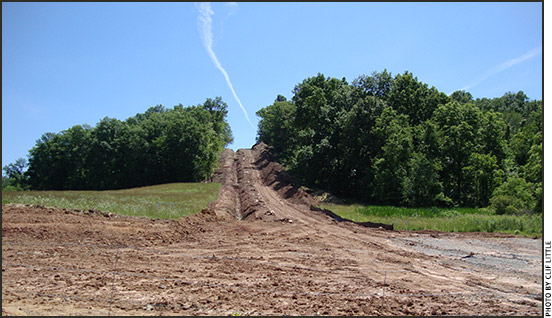
Reseeding Pipelines
OSU Extension offers guidance for reseeding pasture in pipeline rights-of-way.
Farmers who are negotiating easements across their property for shale oil and gas pipelines may want to consider including a clause about when the company should reseed their pastures, a forage expert with Ohio State University’s College of Food, Agricultural, and Environmental Sciences said. Reseeding at the wrong time of year, which appears to be happening frequently, often results in failure, he said.
Farmers need to be aware of the impact that the construction, maintenance and long-term presence these pipelines can have on their property, particularly when it comes to reseeding pipeline rights-of-way pasture and hay areas, said Clif Little, an educator with the college’s outreach arm, Ohio State University (OSU) Extension.
Little and Mark Sulc, an OSU Extension forage specialist, recently wrote a paper, distributed to county Extension educators across the state, that said farmers should be involved in decisions regarding reseeding of pipelines. The paper is online at http://belmont.osu.edu/news/shale-gas-resources-for-landowners.
Timing factor
The difficult issue in reseeding these easements is that installation of the pipeline may occur at any time of year, and when installation is complete, reseeding of the area may occur at a time that is not ideal for forage establishment, they said.
“We’re seeing a lot of pipelines going in across Ohio farmland, and because farmers are hoping to get production off of that land the next year, the timing could impede pasture establishment,” Little said. “The issue is that the majority of pastures and hayfields in Ohio are composed of perennial cool-season grasses and legumes.
“But reseeding of perennial cool-season grasses that occurs during late June thru July 31 and Sept. 15 thru Oct. 30 will likely result in the failed establishment of a perennial cool-season forage. Farmers need to be aware of this, as it’s their farms and their production that is on the line.”
The issue is that pipelines go in when the companies need the infrastructure to transport product, Little said, but the installation and resulting reseeding doesn’t always occur in the ideal time period.
“While in most cases, the shale gas and oil companies are the ones doing the actual reseeding, farmers should try to make sure that they are in charge of the type of forages that are reseeded, and, if they can, also when the reseeding is to occur,” Little said. “This is good for the famer and the pipeline reclamation because both parties want the seeding to take and be successful the first time around.”
During mid-summer, cool-season forages may not germinate, or if they do germinate they may die from heat and dry soil stress. Even if they do germinate and begin to grow, they will not compete well with aggressive warm-season annual weeds such as foxtail and ragweed, he said.
For farmers who aren’t able to ensure a spring reseeding, the best approach for a late seeding involves performing all the preparatory agronomic practices during the summer and then planting the cool-season forages with annual forage at the proper time in August, Little said.
That includes preparing the soil for a proper seedbed; soil testing, applying and mixing in lime, starter nitrogen, phosphate and potassium; followed by seeding and mulching between Aug. 1 and Sept. 1, he said.
The other problematic time to attempt to seed cool-season perennial forages is Sept. 15 thru Oct. 15, as cool-season perennial forages will probably germinate but will not likely establish a root system that is developed enough to carry them through the winter, at least not before a killing freeze occurs, Little said.
Little said that with the late planting, the intended goal is that cool-season perennial grasses not germinate until spring.
“It probably would be better to hold off seeding until early spring to avoid losses of seed viability or from washing of the seed during the winter months,” he said. “Either way, the soil will need to be protected somehow from erosion losses over the winter.”
That could be achieved by planting annual forages such as cereal rye and oats to control erosion even in perennial mixtures, Little said. Other options growers can use include controlling weeds by mowing or using herbicides as soon as they come in.
Growers can find more information, including management and selection tips, in the OSU Extension Ohio Agronomy Guide, Bulletin 472, which can be purchased from any of the 88 OSU Extension offices statewide, Little said.

Editor’s Note: Tracy Turner is a technical writer for Ohio State University Extension, which provided this news release.





